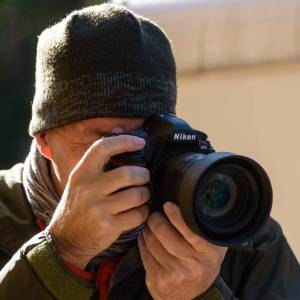A Big Five Safari
To be able to ride at Ant’s Nest, the owner had to make a decision on the diversity of animals kept in the area. While there are three of the the Big Five (the most dangerous African animals in terms of predation) within the area, rhinoceros, Cape buffalo and leopard, they consciously excluded lions and elephants as they would prove to much of a risk to horses and people.
We therefore booked on to a game drive at another lodge, Kololo. The area covered by this reserve is huge, measuring some 80,000 hectares. We headed off two hours before sunset, across a landscape much more open than Ant’s Nest. We soon found ourselves in a mountainous area, coming across new species, including jackals, waterbuck, clip springers, and red wildebeest. The guide was providing a commentary throughout, including references to the droppings of animals, so when he highlighted some fresh elephant dung, we started to get even more excited.
As we came over a small rise there they were in front of us, including a young baby. Getting images of the baby proved very difficult as the group headed away from us in an inaccessible position for the vehicle. We parked up and watched for about 20 minutes as the group moved towards a waterhole. It was then that the watchers became watched as three large females turned and headed towards the vehicle. The guide was explaining the signs that the elephant was being aggressive, but despite our concern he assured us that they were nearly curious at that stage.
Watching the three spread out so they covered an arc in front of us, it still felt quite threatening. We were watching one, then the other, but it was only a short while later that the guide decided that the best option was to retreat and move on!
After that excitement, we stopped shortly afterwards for a refreshment break, across a small river from a female rhinoceros and baby. This was a much more open environment than our encounter with Sophie and new born last week, so we were able to watch for a few minutes while they grazed about 100 yards away. One of the other guests, a representative of a safari company suddenly pointed; she’d seen a leopard near the rhinoceros as it moved into deep grass nearby. We were all hoping to catch another glimpse, but despite everyone training binoculars on the area of grass, it resolutely refused to be spotted again.
Then it was off to see lions as a finally to the drive. Little did the guide realise we were to experience another finale as we turned a corner, when suddenly a bull elephant appeared from behind a tree on the roadside to our left, just feet from the vehicle! Everyone was shocked, most especially those seated on the left of the vehicle. No one even had time to capture an image, so suddenly had it appeared and we were passed before another heartbeat. You could sense the relief amongst the inhabitants of the vehicle that nothing had happened, but also the adrenalin rush it had caused.
By the time we reached the area with the pride of lions it was too dark for any meaningful photography. We were able to watch as a male and female had a late afternoon sojourn, before lying back to back as the light faded.
Then a return to the lodge. We hadn’t realised how far we had travelled, but we endured a night game drive lasting a full hour over and down rocky passes between the mountains, constantly sweeping the road ahead in case any elephants were using the same routes. Most of the roads in the reserve were created along old animal paths. It was explained to us that should we encounter an elephant on the road, we would have to reverse - it reminded me of a film called Hannibal Brookes, where POWs in the war had to assist in the evacuation of a German zoo, complete with elephants. When asked to back up an elephant to allow a high ranking army officer to drive past, the POW, played by Oliver Reed, gleefully explained that elephants couldn’t reverse!
It was an incredibly long day, but well worth the effort to see these animals in their natural environment.

Comments
Sign in or get an account to comment.


